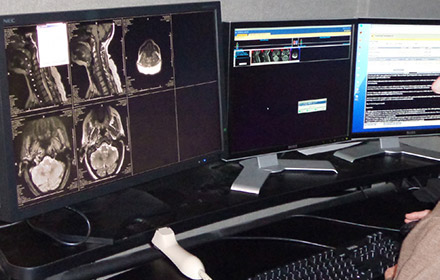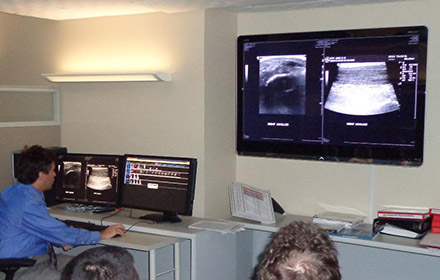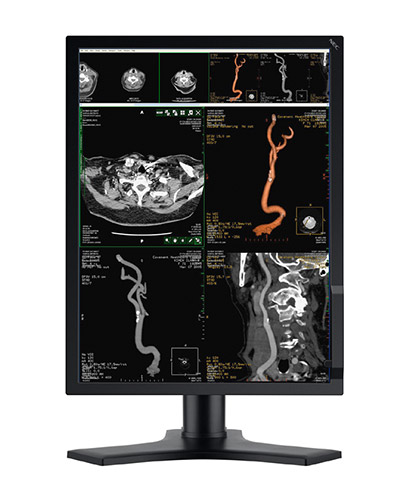NEC Display Solutions Client Installation Healthcare
HENRY FORD HEALTH SYSTEM
NEC MEDICAL MONITORS GIVE HENRY FORD HEALTH SYSTEM RADIOLOGISTS CLEARER INSIGHTS
Since 1895, when German scientist Wilhelm Roentgen discovered the ability of X-rays to pass through solid objects and provide a view of what is inside, medical professionals have relied on the field of medical imaging. Film-based X-rays were the standard until recently, when many hospitals and healthcare facilities started replacing them with digital images – first in the traditional grayscale and later with colored images that helped provide a more detailed look at the inner workings of the human body.
Among the early adopters of digital medical imaging was the Henry Ford Health System (HFHS), one of the leading healthcare providers in the U.S. Staff members helped pioneer the use of digital images in hospitals and have remained at the leading edge.
They were interested in the possibilities color imaging offered for case review and diagnosis, but the cost of the equipment was a significant barrier particularly because they knew that once it was introduced, the entire medical staff would want it.

The Challenge
HFHS converted to filmless radiology in 2002. Before tapping NEC, it had 75 workstations between various facilities, not counting screens used at home by radiologists. The medical displays used for the filmless operations are overseen by Michael J. Flynn, Ph.D., senior staff physicist and bioscience professor at HFHS and professor in nuclear engineering and radiological science at the University of Michigan. Dr. Flynn is also a member of the American Association of Physicists in Medicine (AAPM) and has cowritten the Assessment of Display Performance for Medical Imaging Systems as part of his work. He remains one of the foremost authorities on medical displays for imaging.
As with many healthcare operations, HFHS patient images are initially studied on workstations with multiple high-performance displays for diagnosis, and later images are reviewed in clinical settings by nurses and doctors studying the radiology reports on stations equipped with more mainstream displays. When color imaging first became available, Dr. Flynn, a 30-year veteran in the field of radiology, was intrigued, but he quickly realized it was beyond HFHS’s budget.
“The cost differential between color and grayscale monitors was huge,” said Flynn. “While there were added benefits to using color, they did not justify the expense, so we continued to upgrade our grayscale monitor program.”
One of the major upgrades was a switch in 2007 from the facility’s old monitors, which came from their PC and server supplier, to specialty 3-megapixel (21.3” MultiSync MD213MG) and 5-megapixel (20.1” MultiSync MD205MG) grayscale displays from NEC. Introducing color into the diagnostic process continued to weigh on Flynn’s mind, but timing was crucial, so he waited for the right opportunity.

The NEC Solution
In mid-2010, Dr. Flynn took advantage of a new product release at NEC, the 21.3” MD213MC color display. The price of the MD213MC color monitors was only a few hundred dollars more than the corresponding monochrome device, the MD213MG. He thought the IPS panel and overall quality of engineering made the display an ideal choice for HFHS. The MD213MC is a medical-grade unit with X-Light™ technology for synchronizing pairs of displays and maintaining image stability over the display’s lifetime. With these products, HFHS had an ideal platform for viewing color-enhanced film studies, and it opened up the diagnostic work to achieve new levels of accuracy and interpretation. The hospital purchased 40 of the displays to equip its primary diagnostic radiologists.
“That price drop brought color monitors within reach of our budget,” Flynn said. “We purchased 40 of them right away and installed them in pairs into 20 workstations. The cost to upgrade was so negligible, we decided the time was right to start moving into color. With this kind of pricing, I don’t think the typical grayscale monitors are going to be in the industry much longer.”
HFHS benefited from NEC’s GammaCompMD™ QA software, which ensures consistent image quality, provides a simple interface for conformance to the DICOM standard, as well as an easy-to-use QA environment for medical imaging.
HFHS is finding that the MD213MC monitors provide several advantages over grayscale models. One of the biggest is the ability to produce cross-sectional 3D models that are typically coded in color or have color overlays. The 3D views are often used with images of organs, such as the heart and surrounding arteries. The different organ parts are color-coded for clarity. Dr. Flynn has three people on staff whose job entails producing 3D renderings.
“We do 3D image analysis on a daily basis,” he said. “It’s something that has become embedded in radiology.”
The diagnostic workstations are set up with four NEC displays—two of the MD213MC displays in a portrait orientation for images, and two 23” NEC MultiSync EA231WMi displays for Windows applications, including the navigation functions on the image, dictated text in the voice recognition application and a work list of unread cases.

Also in 2010, Flynn saw the introduction of the 3.7-Megapixel NEC MultiSync PA271W color monitor. The 27” PA271W shares many of the image calibration and stability features of the medical-grade series from NEC, which helped make the choice easier.
The PA271W features a 10-bit color LCD panel and 14-bit lookup tables, which permit a high level of color accuracy, especially in shading and color gradients. This technology proves very useful in reviewing patient scans. The display also has DICOM settings available from the factory and benefits from image stability features similar to NEC’s medical display line.
Sometimes HFHS will bring together several physicians to review various cases with the radiologists. For those situations, the provider has five small-to-medium-sized conference rooms with high-definition displays. Those displays are tied to the radiology stations via an NEC-marketed version of the Matrox Xenia Pro graphics card (MDM-XENPRO). This setup relies on the PA271W as the clinical imaging display, and the three-output video card allows the image from the PA271W to be scaled and displayed on a large-screen LCD for everyone to see.
“We worked on bringing in an accurate image to the conference room for six months,” Dr. Flynn said. “NEC made us aware of this card, which is designed specifically for radiography and PACS stations. We can now bring in a high-resolution image so that our physicians in the conference room see the same content as the radiologists’ workstations.”
Another initiative HFHS has taken to assist medical personnel is the development of ePACS stations – enterprise Picture Archiving and Communications Systems in areas where doctors and nurses perform patient evaluations. Each of these stations now has a single widescreen display that is calibrated to the DICOM grayscale used in radiology.
Dr. Flynn has started using EA231WMi monitors for these ePACS stations with the screen real estate divided to show images on one side of the screen and text on the other.
“We thought going to the wider screen would be a good idea for all the reasons the industry says, particularly for putting up information side-by-side,” Dr. Flynn stated.
“We can put our ePACS data up next to the patient’s information to make it easier to give context to what we’re seeing,” he said. “In practice, it means we can replace two 19” monitors with a single wide monitor, giving us the option of saving money or upgrading to higher-quality screens.”
In doing research on widescreen displays, HFHS found that the NEC monitors provided extremely detailed images and are easy to calibrate precisely, an important point when images are being shared electronically between workstations on different floors or even in different buildings. Given that Dr. Flynn is primarily responsible for imaging quality control at HFHS, this precision and repeatability were high priorities for him.
As with any PACS program, HFHS has been able to eliminate unread cases, provide rapid access to clinicians, improve productivity and reduce the time from when the study is performed to the time it is read. As predicted, the radiologists like having the color imaging available and are anxious for it to be deployed in all 75 workstations.
“NEC has a very good reputation, and the quality of the products has been excellent,” said Flynn. “Our NEC rep has also been very helpful, with suggestions on how to make our systems work the way we want. Working through a major distributor such as CDW-G has worked out very nicely, too. We get the products we want when we need them. That makes it easy to specify NEC across the board.”


